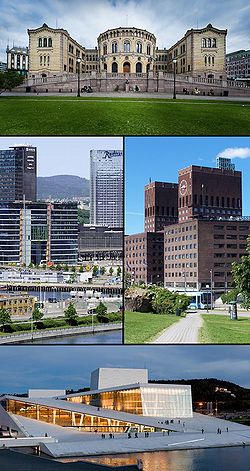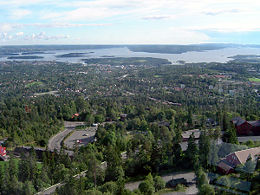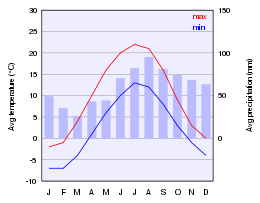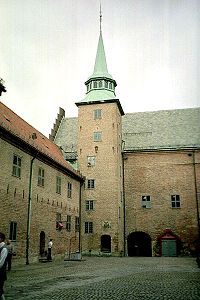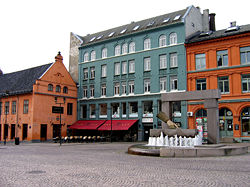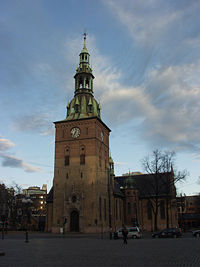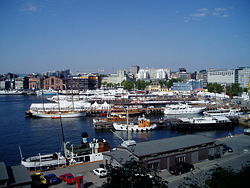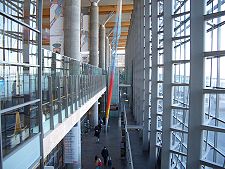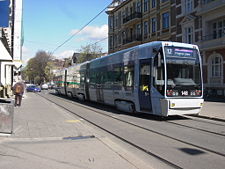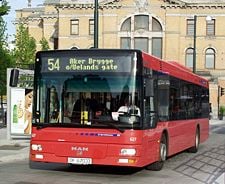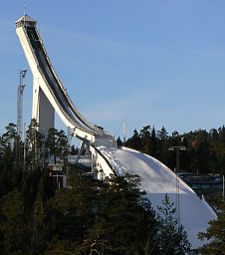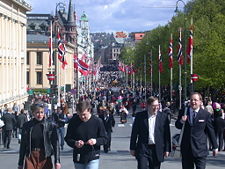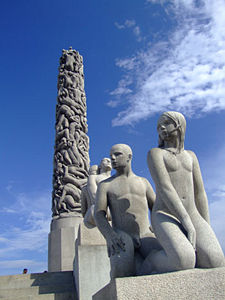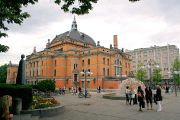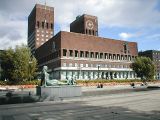Oslo
| Oslo | |||
| Top: Parliament of Norway Building, middle left: Bj√łrvika, middle right: Oslo City Hall seen from Akershus Castle, bottom: Oslo Opera House | |||
|
|||
| Motto: Unanimiter et constanter (Latin: United and constant) |
|||
| Coordinates: 59¬į57‚Ä≤N 10¬į45‚Ä≤E | |||
|---|---|---|---|
| Country | Norway | ||
| District | √ėstlandet | ||
| County | Oslo | ||
| Municipality | |||
| Established | 1048 | ||
| Government | |||
|  - Mayor | Fabian Stang (H) | ||
| ¬†-¬†Governing mayor | Stian Berger R√łsland (H) | ||
| Area | |||
|  - City | 454.03 km² (175.3 sq mi) | ||
|  - Urban | 285.26 km² (110.1 sq mi) | ||
|  - Metro | 8,900 km² (3,436.3 sq mi) | ||
| Population (Jan. 2012) | |||
|  - City | 613,285 | ||
|  - Density | 1,350.8/km² (3,498.4/sq mi) | ||
|  - Urban | 912,046 | ||
|  - Urban Density | 3,197.2/km² (8,280.8/sq mi) | ||
|  - Metro | 1,442,318 | ||
|  - Metro Density | 162.1/km² (419.7/sq mi) | ||
| Time zone | CET (UTC+1) | ||
|  - Summer (DST) | CEST (UTC+2) | ||
| Website: www.oslo.kommune.no | |||
Oslo is the capital and largest city of Norway. It is also a municipality and a county. With a population of 560,484 as of January 1, 2008, it is the third-largest Scandinavian city, after Copenhagen and Stockholm. It is arguably the world's most expensive city in which to live.
According to the Norse legends, Oslo was founded around 1049, by King Harald Hardråde. However, archaeological digs uncovered Christian burials from before 1000, evidencing an earlier urban settlement. After it was destroyed several times by fire, King Christian IV of Denmark (and Norway) in 1624, ordered Oslo rebuilt at a new site across the bay, near Akershus Fortress and given the name Christiania. Christiania went on to regain its stature as a center of commerce and culture in Norway. In January 1838, the city of Oslo was established as a municipality.
About 50 percent of the population of Norway lives within a radius of 74.6 miles of downtown Oslo. The city of Oslo has a current annual growth exceeding 10,000 people, which makes it one of the fastest growing cities in Europe. The Inner Oslo Fjord Region has a total population of about 1.3 million.
Geography and climate
Oslo occupies an arc of land at the northernmost end of the Oslofjord. The fjord, which is nearly bisected by the Nesodden peninsula opposite Oslo, lies to the south; in all other directions Oslo is surrounded by green hills and mountains. There are 40 islands within the city limits, the largest being Malm√łya, and scores more around the Oslofjord. Oslo has 343 lakes, the largest being Maridalsvannet. This is also a main source of drinking water for large parts of Oslo. The highest point is Kirkeberget, at 2,064 feet.
Although the city's population is small compared to most European capitals, it occupies an unusually large land area, of which two thirds are protected areas of forests, hills, and lakes. Its boundaries encompass many parks and open areas, giving it an airy and often very green appearance. It is not uncommon to encounter wild moose in relatively urban areas of Oslo, especially during wintertime.
Oslo has a hemiboreal/humid continental climate (according to the K√∂ppen climate classification system). Summers are mild or even warm, with daily high temperatures averaging between 20.1¬įC and 21.5¬įC during the summer months (June-August). September is often as warm, with colder temperatures usually arriving before the end of October. The highest temperature ever recorded was 35 ¬įC on July 21, 1901. Heatwaves occur several times every summer, from June to late August, with temperatures usually up to 30-31¬įC. The Oslofjord has many public beaches and recreational areas, which are very popular in the summer months. The water temperature usually lies around 20¬įC, and sometimes as high as 23-24¬įC.
The winter is cold, chilly, and wet. Temperatures can drop down to -20¬įC or lower when there is high pressure and blue skies. Almost every winter, ice develops in the inner parts of the fjord, making ice fishing, ice-skating, and even cross-country skiing possible on sea-ice.
Temperatures below zero may be experienced from November until March, the coldest month being January with a mean temperature of -4.3¬įC, and both January and February may have daily minimum temperatures of around -7¬įC. The coldest temperature recorded is -27.9¬įC in February 1871. Snowfall is spread evenly throughout the winter months and on average more than 9.84 inches of snow cover is experienced 30 days per year. Temperatures have tended to be higher in recent years. The annual average precipitation is 30.04 inches, with winter being somewhat drier than summer.
History
According to the Norse sagas, Oslo was founded around 1049, by King Harald Hardråde. Recent archaeological research has uncovered Christian burials from before 1000 revealing evidence of a previous urban settlement. This called for the celebration of Oslo's millennium in 2000. It has been regarded as the capital city since the reign of Håkon V (1299-1319), who was the first king to reside permanently in the city. He also started the construction of the Akershus Fortress. A century later, Norway was the weaker part in a personal union with Denmark, and Oslo's role was reduced to that of provincial administrative center, with the kings residing in Copenhagen. The fact that the University of Oslo was founded as late as 1811 had an adverse effect on the development of the nation.
Oslo was destroyed several times by fire, and after the fourteenth calamity, in 1624, King Christian IV of Denmark (and Norway) ordered it rebuilt at a new site across the bay, near Akershus Fortress and given the name Christiania. But long before this, Christiania had started to regain its stature as a center of commerce and culture in Norway. The part of the city built from 1624, is now often called Kvadraturen because of its orthogonal (meeting at right angles) layout.
In 1814, Christiania once more became a real capital when the union with Denmark was dissolved. Many landmarks were built in the nineteenth century, including the Royal Palace (1825-1848), Stortinget (the Parliament) (1861-1866), the University, Nationaltheatret, and the Stock Exchange. Among the world-famous artists who lived there during this period were Henrik Ibsen and Knut Hamsun (the latter was awarded the Nobel Prize for literature). In 1850, Christiania also overtook the city of Bergen and became the most populous city in the country. In 1878, the city was renamed to Kristiania. The original name of Oslo was restored in 1925.
Oslo's centrality in the political, cultural, and economical life of Norway continues to be a source of considerable controversy and friction. Numerous attempts at decentralization have not appreciably changed this during the last century. While continuing to be the main cause of the depopulation of the Norwegian countryside, any form of development is almost always opposed by neighbors, and as a consequence the growth of a modern urban landscape has all but stopped. Specifically, the construction of highrises in the city center has been met with skepticism. It is projected, however, that the city will need some 20,000 additional apartments before 2020, forcing the difficult decision of whether to build tall or the equally unpopular option of sprawling outwards from the city.
A marked reluctance to encourage the growth of the city for fear of causing further depletion of the traditional farming and fishing communities has led to several successive bursts of construction both in infrastructure and building mass, as the authorities kept waiting in vain for the stream of people to diminish. Neoclassical city apartments built in the 1850s to 1900s, dotted with remnants of Christian IV's renaissance grid dominate the architecture around the city center, except where slums were demolished in the 1960s to construct modernist concrete and glass low-rises, now generally regarded as embarrassing eyesores. The variety in Oslo's architectural cityscape does however provide for some striking, and often hauntingly beautiful sights.
While most of the forests and lakes surrounding Oslo are in private hands, there is great public support for not developing it. Parts of Oslo suffer from congestion, yet it is one of the few European capitals where people live with the wilderness literally in their back yard, or with access to a suburban train line that allows the city's many hikers and long-distance skiers to simply step off the train and start walking or skiing.
Name
The meaning of the name Oslo has been the subject of much debate. It is certainly derived from Old Norse, and was in all probability the name of a large farm at the site of the first settlements in Bj√łrvika.
During the Middle Ages the name was initially spelled √Āsl√≥, later √ďsl√≥. The earlier spelling suggests that the first component √°s refers either to the Ekeberg ridge southeast of the town, or to the Norse homonym meaning "god" or "divinity." The most likely interpretations would, therefore, be "the meadow beneath the ridge" or "the meadow of the gods." Both are equally plausible.
A fire in 1624 destroyed much of the medieval city (the section now known as Gamlebyen), and the city was relocated nearer to the Akershus Fortress. From the end of the 1800s, the name of the city was also spelled "Kristiania." An official decision was never made, so both forms were in use. The original name of Oslo was restored by a law of July 11, 1924, effective January 1, 1925.
Government and politics
Oslo is the capital of Norway, and as such is the seat of Norway's national government. Most government offices, including that of the Prime Minister, are gathered at Regjeringskvartalet, a cluster of buildings close to the national Parliament‚ÄĒthe Storting.
Constituting both a municipality and a county of Norway, the city of Oslo is represented in the Storting by 17 Members of Parliament. Six MPs are from the Labor Party; the Conservative Party and the Progress Party have three each, the Socialist Left Party and the Liberals have two each, and one is from the Christian Democrats.
Oslo has had a parliamentary system of government since 1986. The supreme authority of the city is the City Council (Bystyret), which currently has 59 seats. Representatives are popularly elected every four years. The City Council has five standing committees, each with their own areas of responsibility. These are: Health and Social Welfare, Education and Cultural Affairs, Urban Development, Transport and Environmental Affairs, and Finance. The council's executive branch (Byrådet) consists of a head of government (byrådsleder) and six commissioners (byråder, sing. byråd) holding ministerial positions. Each of the commissioners needs the confidence of the City Council and each of them can be voted out of office.
Since the local elections of 2003, the city government has been a coalition of the Conservative Party and the Progress Party. Based mostly on support from the Christian Democrats and the Liberals, the coalition maintains a majority in the City Council. After the 2007 local elections on September 10, the conservative coalition remained in majority. The largest parties in the City Council are the Labor Party and the Conservatives, with 18 and 16 representatives, respectively.
The Mayor of Oslo is the head of the City Council and the highest-ranking representative of the city. This used to be the most powerful political position in Oslo, but after the implementation of parliamentarism, the Mayor has had more of a ceremonial role, similar to that of the President of the Storting at the national level.
Administrative divisions
Following the latest reform of January 1, 2004, the city is divided into 15 boroughs (bydeler) that are to a considerable extent self governed. Each borough is responsible for local services not overseen by the City Council, such as social services, basic healthcare, and kindergartens. Sentrum (the city center) and Marka, the rural/recreational areas surrounding the city, are separate geographical entities, but do not have an administration of their own. Sentrum is governed by the borough of St. Hanshaugen. The administration of Marka is shared between neighboring boroughs.
Economy
Oslo is an important center of maritime knowledge in Europe and is home to approximately 980 companies and 8,500 employees within the maritime sector, among which are some of the world's largest shipping companies, shipbrokers, and insurance brokers. Det Norske Veritas, headquartered at H√łvik outside Oslo, is one of the three major maritime classification societies in the world, with 16.5 percent of the world fleet to class in its register. The city's port is the largest general cargo port in the country and its leading passenger gateway. Close to 6,000 ships dock at the Port of Oslo annually with a total of six million tons of cargo and over five million passengers.
The gross domestic product of Oslo totaled ‚ā¨33.876 billion in 2003, which amounted to 17 percent of the national GDP. This compares with ‚ā¨20.968 billion in 1995. The metropolitan area, bar Moss and Drammen, contributed 25 percent of the national GDP in 2003 and was also responsible for more than one quarter of tax revenues. In comparison, total tax revenues from the oil and gas industry on the Norwegian Continental Shelf amounted to about 16 percent. The region has one of the highest per capita GDPs in Europe, at ‚ā¨49,465 in 2003. If Norway were a member of the European Union, the capital region would have the fourth strongest GDP per capita, behind Inner London, Brussels-Capital, and Luxembourg.
Oslo is one of the most expensive cities in the world. As of 2006, it is ranked tenth according to the Worldwide Cost of Living Survey provided by Mercer Human Resource Consulting. The reason for this discrepancy is that the EIU omits certain factors from its final index calculation, most notably housing. Although Oslo does have the most expensive housing market in Norway, it is comparably cheaper to other cities on the list in that regard. Meanwhile, prices on goods and services remain some of the highest of any city. According to a report compiled by the Swiss bank UBS in the month of August 2006 Oslo and London were the world's most expensive cities. Total pay packets were the biggest in Oslo along with Copenhagen and Zurich, but residents of the Nordic cities lose out when tax is taken into account.
Demographics
An estimated 19.6 percent of Oslo's population consists of immigrants from outside the West. Pakistanis (20,036) and Sri Lankan Tamils (7,128) are the two largest ethnic minority groups. Other large groups are people from the former Yugoslavia, Vietnam, Philippines, Turkey, Somalia, Iraq, and Morocco.
The population of Oslo is currently increasing at a record rate of nearly two percent annually (17 percent over the last 15 years), making it the fastest-growing Scandinavian capital. In particular, immigration from Poland and the Baltic states has increased sharply since the accession of these countries to the EU in 2004.
Society and culture
Institutions of higher education
Oslo alone now has over 50 schools, colleges and universities, including: the University of Oslo, Oslo University College, Norwegian School of Management, Norwegian School of Information Technology, Oslo School of Architecture and Design, Norwegian University of Sport and Physical Education, Norwegian Academy of Music, MF Norwegian School of Theology, Oslo National Academy of the Arts, Norwegian University of Life Sciences, Norwegian Military Academy, Norwegian School of Veterinary Science, and the Oslo Academy of Fine Arts.
Transport
Air
- Oslo Airport, Gardermoen served by high speed train (Flytoget)
- Sandefjord Airport, Torp (in Vestfold county about two hours, or 68.4 miles away)
- Moss Airport, Rygge (In √ėstfold county, 37.3 miles away)
Sea
There are daily ferry connections to Kiel (Germany), Copenhagen (Denmark), Frederikshavn (Denmark), and Nesodden.
Public ferries run daily to and from the islands scattered in the Oslo harbor basin.
Train
Oslo Sentralstasjon is the main railway station in Oslo. From there, there are connections in the directions of: Trondheim, Bergen, Stavanger, Stockholm (Sweden), Gothenburg (Sweden) and Copenhagen (Denmark). In 2004, Norwegian trains were Europe's third most-punctual national train company. For the four first months in 2005, the punctuality was 92.9 percent. During winter in particular, weather conditions such as snow and blizzards may cause delays and cancellations on the routes crossing the central mountains.
Local transport
The public transportation system in Oslo is managed by the municipal transport company Oslo Sporveier. This includes metro, tram, bus, and ferry, but not the local train lines, which are run by the state railway company NSB. All public transport in Oslo operates on a common ticket system, allowing free transfer within a period of one hour with a regular ticket. Tickets also transfer to the local and inter-city trains, unless you intend to cross the city border. In 2004, 160 million journeys were made using public transport, of which 85 percent was handled by Oslo Sporveier's own subsidiaries and 15 percent by private bus and ferry operators under cost-based contracts.
The tram system, Oslotrikken, is made up of six lines that criss-cross the inner parts of the city and extend out towards the suburbs. The metro system, known as the T-bane, connects the eastern and western suburbs and comprises six lines which all converge in a tunnel beneath downtown Oslo. The metro lines are identified by numbers from 1 to 6, with two lines running into the municipality of Bærum in the west. The tramway lines are numbered 11 to 13 and 17 to 19.
A new, partially underground loop line was opened in August 2006, connecting Ullevål in the north-west and Carl Berners plass in the east. Two new stations, Nydalen and Storo, have been operational for a couple of years already, the third station, Sinsen, opened August 20 2006. This completed the loop. In conjunction with the opening of the circle line, there will be a major upgrade of the rolling stock, with delivery taking place between 2007 and 2010. An RFID ticketing system with automatic turnstile barriers has been under construction for several years, but has been heavily delayed and is not yet in service.
Roads
Access into the city center requires the payment of a toll at one of 19 entry points around the ring road. It costs 25 NOK to enter the cordoned zone at all times of day, seven days a week, although a season ticket is available. Since February 2, 2008, coins are no longer accepted at the Toll Station, and all cars must pass through the automatic lanes without stopping. If you are fitted with the electronic AutoPASS system then you will be debited as you pass, all other drivers will receive a bill in the post.
Initially revenues from the road tolls funded the public-road network, but since 2002, it mainly finances new developments for the public transport system in Oslo. There has been discussion whether to continue to use the cordon after 2007, based on the funding decisions, extensions, accommodation of time-differentiated pricing, or replace it by another form of pricing altogether, perhaps to make congestion pricing possible.
Media
The newspapers Aftenposten, Verdens Gang, Dagbladet, Dagsavisen, Morgenbladet, Vårt Land, Nationen, and Klassekampen are published in Oslo. The main office of the national broadcasting company NRK is located at Marienlyst in Oslo, near Majorstuen. TVNorge (TVNorway) is also located in Oslo, while TV2 (based in Bergen) and TV3 (based in London) operate branch offices in central Oslo. There is also a healthy variety of specialty publications and smaller media companies.
Sports
Oslo was the host city for the 1952 Winter Olympics. Except for the downhill skiing at Norefjell, all events took place within the city limits. The opening and closing ceremonies were held at Bislett stadion, which was also used for the speed skating events. In recent years, the stadium has been better known for hosting the annual Bislett Games track and field event in the IAAF Golden League. The stadium was rebuilt in 2004/2005, and was formally opened for the Bislett Games on July 29, 2005.
Holmenkollen nordic skiing arena, and its centerpiece, the ski jump, was an important venue during the 1952 Olympics. The arena has hosted numerous Nordic skiing and biathlon world championships since 1930, and its ski-jump competition is the second oldest in the world, having been contested since 1892. Holmenkollen has been selected to once again host the FIS Nordic World Ski Championships, in 2011.
During the summer months, the harbor becomes a venue for various maritime events, including the start of a large sailing regatta that attracts around 1,000 contesting boats each year, and one race of the international Class 1 offshore powerboat racing circuit.
Two football (soccer) clubs from Oslo, V√•lerenga and Lyn, play in the Norwegian Premier League. In the 2005 season, the teams placed first and third respectively. In addition, two teams from the conurbations are represented‚ÄĒStab√¶k Fotball and Lillestr√łm Sportsklubb. Oslo had two ice hockey teams in the highest division in the previous season, V√•lerenga Ishockey and Furuset I.F., the former winning the cup and league double in 2007. Speed skating is also held at the Valle Hovin venue, which in the summer is host to large popular music concerts.
Ullevaal stadion, located in the borough of Nordre Aker, is the home of the Norwegian national football team. Built in 1926, it is the largest football stadium in Norway, and has served as the venue for the Norwegian Cup final since 1948. Both Lyn and V√•lerenga use the stadium as their home ground. Oslo is also home of the Norway Cup‚ÄĒthe world's biggest football tournament for youth from all over the world.
National Day
Norway celebrates its national day on May 17, as Norwegians dress up in their most beautiful clothes and walk down the main streets of Oslo in huge parades waving Norwegian flags. The holiday is as big as Christmas, with many festivities and traditions associated with it.
Main sights
- New national opera
- Akershus Castle and Fortress
- Norsk Folkemuseum, the Norwegian Museum of Cultural History at Bygd√ły, with a large open air museum
- The Armed Forces Museum
- The City Hall, where the annual Nobel Peace Prize ceremony is held
- The Nobel Peace Center, Aker brygge
- The New National Opera House, Bj√łrvika
- The Historical Museum
- The Museum of Modern Art
- The Holmenkollen ski jump, arena of the 1952 Winter Olympics and the Holmenkollen ski festival, Holmenkollen
- The Holmenkollen Ski Museum, Holmenkollen
- The Kon-Tiki Museum, Bygd√ły
- The Munch Museum, T√łyen
- The river Akerselva
- The National Gallery
- The Norwegian Maritime Museum, including Gj√ła, Bygd√ły
- The Fram Museum, exhibiting the ship Fram, Bygd√ły
- The Oslo City Museum, at Frogner Manor
- The Royal Palace
- The Henie-Onstad Art Centre, H√łvikodden in B√¶rum
- Oslo Cathedral
- Norwegian Museum of Science and Technology
- The Zoological Museum, T√łyen
- The Botanical garden, T√łyen
- The Storting, parliament building
- The Vigeland Park in the Frogner park (Frognerparken)
- The Viking Ship Museum, displaying ships from Gokstad, Oseberg, and Tune at Bygd√ły
- Tryvannstårnet
- Hoved√łya
- Ullevål Hageby
- The islands of the Oslofjord
ReferencesISBN links support NWE through referral fees
- Burgess, Ann Caroll, and Tom Burgess. Oslo. Peterbrough, England: Thomas Cook, 2008. ISBN 978-1841578859.
- Everyman Mapguides. Oslo. London: Everyman, 2007. ISBN 978-1841592671.
- Sjovold, Thorleif. The Viking Ships in Oslo. Universitetets Oldsakssamling, 1985.
- Taylor, Doreen, et al. Oslo & Bergen (pocket guide). Singapore: APA, 2006. ISBN 978-9812582782.
External links
All links retrieved November 17, 2022.
- Official Travel Guide to Oslo www.visitoslo.com
| |||||||
| |||||||
Credits
New World Encyclopedia writers and editors rewrote and completed the Wikipedia article in accordance with New World Encyclopedia standards. This article abides by terms of the Creative Commons CC-by-sa 3.0 License (CC-by-sa), which may be used and disseminated with proper attribution. Credit is due under the terms of this license that can reference both the New World Encyclopedia contributors and the selfless volunteer contributors of the Wikimedia Foundation. To cite this article click here for a list of acceptable citing formats.The history of earlier contributions by wikipedians is accessible to researchers here:
The history of this article since it was imported to New World Encyclopedia:
Note: Some restrictions may apply to use of individual images which are separately licensed.
